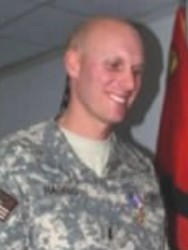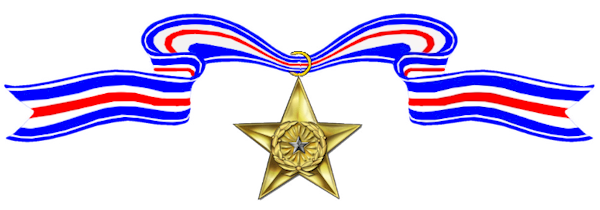Jonathan Harris enlisted in US Marine Corps for four years in 1995 and then joined the Army in 1999. On the date that his Silver Star was awarded, his father also received a late award of the Silver Star (it had been awarded but never presented) for his own heroism in the Vietnam War. Father and son received their medals simultaneous from different locations via a Video Tele Conference.

Awards Received
-

Silver Star
-
Silver Star
Service:
United States ArmyRank:
Chief Warrant Officer Two (CWO-2)Batallion:
5th BattalionRegiment:
101st Aviation RegimentDivision:
101st Airborne DivisionAction Date:
July 2, 2008
The President of the United States of America, authorized by Act of Congress July 9, 1918 (amended by an act of July 25, 1963), takes pleasure in presenting the Silver Star to Chief Warrant Officer Two (CWO-2) Jonathan W. Harris, United States Army, for exceptional gallantry displayed against enemy forces on 2 July 2008, while serving with the 5th Battalion, 101st Aviation Regiment, 101st Airborne Division, in support of Operation COMMANDO STRIKE during Operation ENDURING FREEDOM IX in the CENTCOM AOR. Chief Warrant Officer Two Harris’ exceptional achievements as the flight lead Pilot-in-Command of aircraft 440 were directly responsible for saving the lives of his entire crew. His efforts were nothing less than heroic and are in the finest traditions of military service. On 2 July 2008, Chief Warrant Officer Two Harris was the Pilot-in-Command of a UH-60L conducting an Air Assault in order to kill or capture a known mid-level Taliban commander operating in the vicinity of Gardez, Afghanistan. Chief Warrant Officer Two Harris was the Flight Lead for the mission, responsible for ensuring that the entire flight arrived at the objective on time, on target. The Helicopter Assault Force (HAF) successfully inserted the Ground Force on the objective and returned to Gardez to refuel. The Ground Force Commander (GFC) called that his mission was accomplished and he was ready for extraction. While en route back to the objective, the GFC called and changed the intended Pick-up Zone (PZ). Due to enemy contact, the GFC needed to be extracted from the same location that he had been inserted. In a superior display of airmanship, Chief Warrant Officer Two Harris adjusted his route, developed a new landing plan, and briefed his crew and the rest of the flight, all while the flight was inbound to the objective. Even with the last minute changes, Chief Warrant Officer Two Harris still led the flight to the exact landing zone, exactly on time. Chief Warrant Officer Two Harris was on the ground waiting for the Ground Forces to load his aircraft when a large number of previously undetected insurgents unleashed a barrage of fire at the extremely vulnerable aircraft. They initiated the complex ambush using automatic rifle fire from a line of trees, followed immediately by two Rocket Propelled Grenades (RPGs) landing on both sides of the aircraft, and a large caliber anti-aircraft artillery (AAA) system (believed to be a DShK) positioned on a nearby hill. A third RPG impacted on the left side of the aircraft in the vicinity of the fuel tank. Despite the damage the aircraft sustained, Chief Warrant Officer Two Harris immediately analyzed the situation and understood that he could not remain in his present location. He coaxed his crippled aircraft into the air in order to get clear of the murderous fire. Displaying remarkable situational awareness in light of his present circumstances, he flew to the east to remain clear of the other aircraft, yet remained close to the ground to avoid the AAA system and simultaneously began making radio calls to inform the rest of the flight and call in air support. Once in the air, the crewmembers discovered the aircraft was on fire. With the cabin quickly filling with smoke and flames pouring from the engine, Chief Warrant Officer Two Harris quickly identified a dusty, uneven field, on which he instructed the pilot on the controls to perform an emergency landing. As the tail wheel of the aircraft contacted the ground, Chief Warrant Officer Two Harris performed an emergency engine shutdown to cut off the fuel supply to the engines. Once on the ground, Chief Warrant Officer Two Harris directed the crew to egress the aircraft with all available weapons and ammunition. Chief Warrant Officer Two Harris’ Crew Chief discovered he had sustained several shrapnel wounds in his left arm and buttocks from the RPG blast and had difficulty exiting the aircraft. Chief Warrant Officer Two Harris assisted his Crew Chief from the burning aircraft and began to remove the window-mounted machine gun. The crew gathered at the nose of the aircraft as briefed and Chief Warrant Officer Two Harris took accountability and instructed the crewmembers to setup a defensive perimeter around the aircraft. Chief Warrant Officer Two Harris spotted an inbound CH-47 and instructed the crewmembers to assemble and begin movement towards the intended hasty PZ. As they conducted movement towards the aircraft they realized that they were taking fire. They conducted a halt to assess the situation and Chief Warrant Officer Two Harris realized his Crew Chief had fallen several meters behind. Chief Warrant Officer Two Harris dodged incoming fire to return to his Crew Chief’s position. The Crew Chief, who was still dazed from the blast, fumbling desperately with his machine gun to convert it for ground operation, had not realized small arms fire was striking the ground all around his position. Chief Warrant Officer Two Harris knelt on top of his Crew Chief, with no regard to his own safety, and spotted an insurgent charging towards their position. The attacker was within 70 yards as Chief Warrant Officer Two Harris engaged and killed the enemy fighter. Two hundred meters from the crash site enemy forces began pouring out of a compound placing sporadic gun fire in their general direction. Realizing the imminent danger of the rapidly approaching enemy forces advancing towards the crew, Chief Warrant Officer Two Harris started engaging the advancing personnel, suppressing the combatants and slowing their advance to allow his fellow crewmembers to continue movement to the inbound aircraft. After the inbound CH-47 landed, a ten man team exited the aircraft and began to suppress the enemy forces. Chief Warrant Officer Two Harris assisted his Crew Chief, virtually dragged him to safety; all the while he continued to suppress the advancing enemy personnel. As the aircraft prepared for takeoff, Chief Warrant Officer Two Harris remained outside the ramp and continued to provide accurate suppressive fire until all personnel were securely aboard the aircraft only then climbing aboard and flying to safety. Three American Soldiers owe their lives to Chief Warrant Officer Two Harris’ heroic actions. His extraordinary actions are in keeping with the finest of military traditions and reflect great credit on him, Task Force Shadow, Task Force Destiny, the Combined Joint Task Force 101, and the United States Army.

